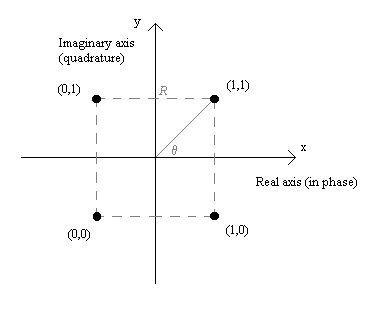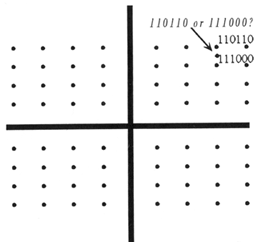Evolution from "V.dot" Modem Technology
In many ways, ADSL modems are an extension of current analog modem
technologies. Shared features include:
Each of these will now be discussed with relations to V.dot modems
and ADSL modems. The use of the Discrete Multi-Tone Modulation method
in ADSL will be discussed on the next page.
Quadrature Amplitude Modulation (QAM)
With QAM, two independent messages are each separately modulated onto
orthogonal versions of the same carrier frequency (e.g. sine and cosine)
A QAM signal can be represented by:

Where x (t) and y (t) are called the in-phase and quadrature phase
components respectively. QAM is a form of multilevel signaling, and a
4-symbol QAM is simply called 4-QAM. In essence, QAM modulates both
the amplitude and phase of the carrier signal. We represent QAM
signals diagrammatically using Constellation Maps. For 4-QAM, its
constellation map would look like:

Figure 5. 4-QAM Constellation Map
The bit values for this are:
|
Bit Values |
Amplitude |
Phase |
|
00 |
1 |
45o |
|
01 |
1 |
135o |
|
11 |
1 |
225o |
|
10 |
1 |
315o |
Table 3. Bit values for 4-QAM
Clearer, by increasing the constellation size, we get a corresponding
increase in bits/symbol resulting in a better utilisation of
bandwidth. However, due to channel noise and/or interference,
increasing the constellation size decreases the accuracy associated
with determining the correct point on the map. This is because as
more and more symbols appear on the constellation map (e.g. 64-QAM),
the amplitude and phase difference between adjacent symbols become
smaller and ambiguities can occur during deciphering of symbols in
presence of noise. The following diagram illustrates this:

Figure 6. Ambiguity in 64-QAM. Source: [9]
Multi-Dimensional Trellis Coding
From the above scenario, it follows that increasing the distance
between symbols decreases the ambiguities of detecting the correct
symbols. This is exactly what Trellis Coding attempts to do. This
method introduces redundant bits into the bit stream, and expands the
constellation map without increasing the bandwidth. This advancement
was first implemented in V.32 modems and has been used in all other
V.dot modems eversince. An improvement on this is 2-D Trellis coding,
which in effect doubles the constellation size by introducing
redundancy in 2D space. However, for large constellations, as the
constellation size increases, ambiguities in deciphering are
re-introduced. It is therefore desirable to add redundancy to the bit
stream without increasing the constellation size. Taking this one
step further, if the redundant bits were distributed in
multi-dimensional space, then the number of bits/symbol mapped to a
2D space would be less. Hence it is possible to introduce redundancy
without doubling the constellation size. 4D Trellis coding is
considered the best compromise between complexity and performance.
For more information on Multi-Dimensional Trellis Coding, please
refer to textbooks on coding and modulation.
Echo Cancellation
Echo cancellation modems have overlapping upstream and downstream
channels. Echo cancellation is necessary to minimise the reflections
hence allowing the modem to achieve full duplex. See explanation on previous
page.
Handshaking protocol
Handshaking allows two modems to negotiate features and mode
parameters. (E.g. for V.34 modems, the handshake protocol is V.8).
Features include: which modulation, error correction, and data
compression to use and at what speed. The handshake protocol for ADSL
is G.hs defined by the ITU. This protocol will allow two ADSL modems
to negotiate the most suitable parameters and features to use during transmission.
Training
During initialisation, one modem transmits a known bit stream to
another modem. Using the received bit stream and comparing it with
the original, the modem is able to determine the line condition and
compensate for any non-linearity. Non-linearities are caused by the
equipment and by the twisted pair. Higher frequencies get attenuated
more than lower frequencies in the wires. Since ADSL modems are
"always connected", it will be necessary to perform
training periodically. Training consumes time, especially for modems
with high transmit rates. Therefore, fast training procedures are
critical for ADSL modems since they reach speeds of up to 8Mbps.
Additional requirements will be necessary to support ADSL modems
without a POTS splitter.



![]()


